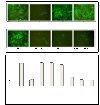Intracellular expression of IRF9 Stat fusion protein overcomes the defective Jak-Stat signaling and inhibits HCV RNA replication
- PMID: 20939906
- PMCID: PMC2964675
- DOI: 10.1186/1743-422X-7-265
Intracellular expression of IRF9 Stat fusion protein overcomes the defective Jak-Stat signaling and inhibits HCV RNA replication
Abstract
Interferon alpha (IFN-α) binds to a cell surface receptor that activates the Jak-Stat signaling pathway. A critical component of this pathway is the translocation of interferon stimulated gene factor 3 (a complex of three proteins Stat1, Stat2 and IRF9) to the nucleus to activate antiviral genes. A stable sub-genomic replicon cell line resistant to IFN-α was developed in which the nuclear translocation of Stat1 and Stat2 proteins was prevented due to the lack of phosphorylation; whereas the nuclear translocation of IRF9 protein was not affected. In this study, we sought to overcome defective Jak-Stat signaling and to induce an antiviral state in the IFN-α resistant replicon cell line by developing a chimera IRF9 protein fused with the trans activating domain (TAD) of either a Stat1 (IRF9-S1C) or Stat2 (IRF9-S2C) protein. We show here that intracellular expression of fusion proteins using the plasmid constructs of either IRF9-S1C or IRF9-S2C, in the IFN-α resistant cells, resulted in an increase in Interferon Stimulated Response Element (ISRE) luciferase promoter activity and significantly induced HLA-1 surface expression. Moreover, we show that transient transfection of IRF9-S1C or IRF9-S2C plasmid constructs into IFN-α resistant replicon cells containing sub-genomic HCV1b and HCV2a viruses resulted in an inhibition of viral replication and viral protein expression independent of IFN-α treatment. The results of this study indicate that the recombinant fusion proteins of IRF9-S1C, IRF9-S2C alone, or in combination, have potent antiviral properties against the HCV in an IFN-α resistant cell line with a defective Jak-Stat signaling.
Figures










Similar articles
-
SH2 modified STAT1 induces HLA-I expression and improves IFN-γ signaling in IFN-α resistant HCV replicon cells.PLoS One. 2010 Sep 30;5(9):e13117. doi: 10.1371/journal.pone.0013117. PLoS One. 2010. Retraction in: PLoS One. 2024 Nov 5;19(11):e0313111. doi: 10.1371/journal.pone.0313111. PMID: 20949125 Free PMC article. Retracted.
-
Differential regulation of Tetraodon nigroviridis Mx gene promoter activity by constitutively-active forms of STAT1, STAT2, and IRF9.Fish Shellfish Immunol. 2014 May;38(1):230-43. doi: 10.1016/j.fsi.2014.03.017. Epub 2014 Mar 27. Fish Shellfish Immunol. 2014. PMID: 24680831
-
IL28B inhibits hepatitis C virus replication through the JAK-STAT pathway.J Hepatol. 2011 Aug;55(2):289-98. doi: 10.1016/j.jhep.2010.11.019. Epub 2010 Dec 13. J Hepatol. 2011. PMID: 21147189 Free PMC article.
-
The unique role of STAT2 in constitutive and IFN-induced transcription and antiviral responses.Cytokine Growth Factor Rev. 2016 Jun;29:71-81. doi: 10.1016/j.cytogfr.2016.02.010. Epub 2016 Mar 18. Cytokine Growth Factor Rev. 2016. PMID: 27053489 Review.
-
The emerging role of interferon regulatory factor 9 in the antiviral host response and beyond.Cytokine Growth Factor Rev. 2016 Jun;29:35-43. doi: 10.1016/j.cytogfr.2016.03.002. Epub 2016 Mar 4. Cytokine Growth Factor Rev. 2016. PMID: 26987614 Review.
Cited by
-
Direct Inhibition of IRF-Dependent Transcriptional Regulatory Mechanisms Associated With Disease.Front Immunol. 2019 May 24;10:1176. doi: 10.3389/fimmu.2019.01176. eCollection 2019. Front Immunol. 2019. PMID: 31178872 Free PMC article. Review.
-
ISGF3 and STAT2/IRF9 Control Basal and IFN-Induced Transcription through Genome-Wide Binding of Phosphorylated and Unphosphorylated Complexes to Common ISRE-Containing ISGs.Int J Mol Sci. 2023 Dec 18;24(24):17635. doi: 10.3390/ijms242417635. Int J Mol Sci. 2023. PMID: 38139463 Free PMC article.
-
Downregulation of TIPE2 mRNA expression in peripheral blood mononuclear cells from patients with chronic hepatitis C.Hepatol Int. 2013 Jul;7(3):844-9. doi: 10.1007/s12072-013-9435-2. Epub 2013 Apr 5. Hepatol Int. 2013. PMID: 26201921
-
STAT1 is essential for the inhibition of hepatitis C virus replication by interferon-λ but not by interferon-α.Sci Rep. 2016 Dec 8;6:38336. doi: 10.1038/srep38336. Sci Rep. 2016. PMID: 27929099 Free PMC article.
-
Hepatitis C Virus Infection Induces Autophagy as a Prosurvival Mechanism to Alleviate Hepatic ER-Stress Response.Viruses. 2016 May 23;8(5):150. doi: 10.3390/v8050150. Viruses. 2016. PMID: 27223299 Free PMC article. Review.
References
Publication types
MeSH terms
Substances
Grants and funding
LinkOut - more resources
Full Text Sources
Research Materials
Miscellaneous

